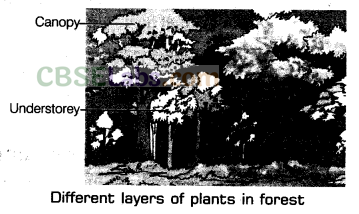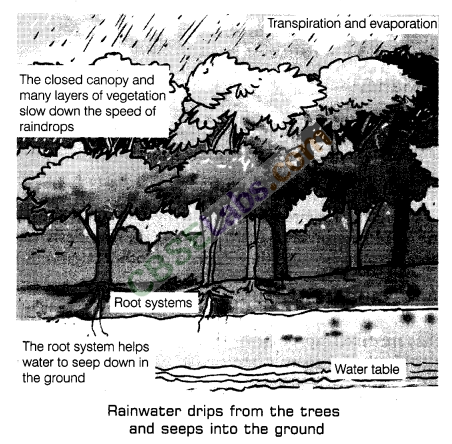CBSE Class 7 Science Notes Chapter 17 Forests: Our Lifeline Pdf free download is part of Class 7 Science Notes for Quick Revision. Here we have given NCERT Class 7 Science Notes Chapter 17 Forests: Our Lifeline.
CBSE Class 7 Science Notes Chapter 17 Forests: Our Lifeline
In ancient times, we used to live in forests. It met all our requirements for leading a normal life at that time. Now-a-days, we live in cities and towns far off from forests, so we really do not know the importance of forests in our life. It is a natural renewable resource a habitat (home) to many forms of wildlife like bear, bison, jackal, deer, porcupine, elephant, etc.
Many trees like sal, teak, semal, Sheesham, neem, Palash, fig, khair, amla, bamboo, kachnar and many others are also found in the forests. The forest also contains insects, butterflies, honeybees and birds which help in palliation in the flowering plants of the forest in pollination.
Structure of a Forest
The plants (trees, shrubs and herbs) make different layers in the forest which are described below:
1. Canopy
The uppermost branches and leaves of tall trees which act as a roof over the forest ground is called canopy. It is the highest layer of vegetation in the forest. The branch part of a tree above the stem is known as the crown of the tree.
2. Understorey
The different horizontal layers formed due to different types of crowns in the forest is called understorey. The constituents of understorey can be described as follows:

(i) Top layer It constitutes the gaint and tall trees followed by shrubs and tall grasses.
(ii) Shrub layer It has many shrubs and bushes of approximately 1-2 metres of height from the forest floor. It makes dense layer at some places of forest where enough sunlight is present.
(iii) Herb layer Just below the shrub layer occurs the herb layer of plants. It is the lowest layer of vegetation in the forest (having leafy plants). Most of the plants in herb layer have short lifespan.
(iv) Forest floor Plants found here are as small as mosses, liverworts, lichens. It has many kinds of insects, worms, toad stool, etc. Most of the forest floor is covered with dead and decaying plant matter, and animal waste.
Components of the Forest
The living organisms found in the forest are plants, animals, decomposers and scavengers. The non-living environment of the forest provides nutrients, water and carbon dioxide for the growth of the plants.
1. Plants
Green plants are living organisms also called autotrophs as they produce food by photosynthesis (by absorbing nutrients water from soil, CO2 from air and sunlight as energy source). They provide food to all living organisms which live in the forest. They are called producers (of food).
2. Animals
Forests have many animals and they are called consumers (of food). The animals which eat only plants/their parts are called herbivores (herb eating) whereas flesh-eating animals are called carnivores. All animals are called heterotrophs because they depend on other organisms for food.
3. Decomposers
Mostly these organisms are microorganisms like bacteria and fungi. They feed on dead plants and animals and thus are called saprotrophs. These organisms are also called decomposers as they breakdown dead parts of plants and dead bodies of animals into simple substances. They play a very important role in sustaining the forests.
4. Scavengers
Those animals which eat dead animals are called scavengers, e.g. vultures, crows, jackals, hyena, some insects (ants, beetles, termites, woodlice, maggots, millipedes and earthworms), etc. Scavengers are the cleaning agents of our environment. But these are not decomposers as they do not breakdown complex dead organic matter into simple ones.
Importance of Forests
The forests provide us with a large number of products. They also purify air and water quality and maintain soil moisture and climate. So, they are called lifeline.
1. Forests Provide Many Useful Products
The various things which are obtained from the forests are called forest products. Forests give us a large number of useful products. Some of the important products which we get from the forests are wood, honey, gum, sealing wax (or lac), catechu (kattha), fruits, oils, spices, natural rubber, cork, dyes, medicinal plants and fodder for cattle. Perhaps the most important product obtained from forests is the wood (which is obtained by cutting down the forest trees). The wood obtained from forests is used for a large number of purposes in our day-to-day life.
2. Forests Maintain Balance between Oxygen and Carbon Dioxide
Plants in the forest release oxygen during photosynthesis. This provides all animals including us with oxygen to breathe and helps to maintain the ratio of oxygen to carbon dioxide in the atmosphere. That is why, forests are called green lungs.
If the amount of carbon dioxide increases in the atmosphere, it would result in an increase in earth’s temperature. Plants in the forest intake carbon dioxide from the atmosphere during photosynthesis. Hence, they help to maintain the right amount of carbon dioxide in the atmosphere.
3. Forests Maintain Water Cycle
The forest trees suck water from the soil through their roots and release water vapour into the air through transpiration. This water vapour helps in the formation of clouds and bring rain on the earth. Thus, forests bring sufficient rainfall on the earth. In fact, about half the rain which falls in forest areas comes from the transpiration of forest trees themselves. In this way, forests help in maintaining a perfect water cycle in nature and meet our freshwater requirements.

4. Forests Prevent Occurrence of Flood
The forest acts as a natural absorber of rainwater and allows it to seep. It helps to maintain the water table throughout the year. Forests not only help in controlling floods but also help to maintain the flow of water in the streams so that we get a steady supply of water.
On the other hand, if trees are not present, rain hits the ground directly and may flood the area around it. Heavy rain may also damage the soil. Roots of trees normally bind the soil together, but in their absence, the soil is washed away or eroded.
The different kinds of plants grow together in the forest making different levels of layers and habitat for wild animals. In the absence of plants/trees, the soil will not hold water which will cause flood and erosion.
5. Forests Provide Habitat for Wildlife
The different types of vegetation present in a forest provide food and shelter to animals, birds and insects which live in the forest. This makes a food chain.
Food chain
Food chain can be defined as a sequence of living organisms in which one organism feeds on another.
A typical chain in grassland is: grass → deer → lion
A typical food chain in a pond is: algae → small fish → large fish
Flow of Energy in a Food Chain
The sun is the ultimate source of energy for everything on the planet. Green plants or producers are able to harness the energy of the sun to make food. In a food Flow ener0y in food chain chain, energy from plants (producers) is passed on from one organism to another. From the producers, the energy goes to primary consumers (herbivores) and is then passed on to secondary consumers (carnivores). Thus, producers are always at the beginning of the food chain.

Dynamic Living Entity
By harbouring greater variety of plants, the forest provides great opportunities of food and habitat for the herbivores. Larger number of herbivores means increased availability of food for a variety of carnivores. The wide variety of animals helps the forest to regenerate and grow. Decomposers help in maintaining the supply of nutrients to the growing plants in the forest. Therefore, the forest is a dynamic living entity. There is a continuous interaction between soil, water, air, plants and animals in a forest.
6. Forests can Regenerate on their Own
The dead parts of trees and plants, dead animals and animal wastes (like animal dung or droppings) keep on collecting on the forest floor. Decomposers (fungi and bacteria) degrade them into simple organic substances which are usable by plants in the form of humus. The hummus makes the forest soil fertile by providing the nutrients. The animals, birds of forests, wind and water disperse the seeds of trees and plants on the forest soil. These seeds obtain nutrients from the soil and germinate to form seedlings and ultimately grow to form the forest vegetation.
Forest Conservation
Paper is made from wood pulp that is produced from the wood of forest trees. So, to make paper, many trees have to be cut down from the forests. If all of us keep on collecting old newspapers, magazines, books, notebooks, etc., and send them to paper mills for recycling through a junk dealer (kabaddi wala), we will be able to save many forest trees from being cut down.
Some of the other ways to conserve forests are also given below:
- Excessive cutting down of forest trees should not be allowed by the government to conserve forests.
- More trees should be planted in the forest in place of cut down trees to conserve forests.
- Paper products such as old newspapers, magazines, books, notebooks, etc., should be recycled to conserve forests.
A large number of forest trees are being cut down every day to meet the various demands of the increasing population. This is called deforestation. Following are the consequence if forests disappear:
- Increase of the earth’s temperature If there are no trees and plants, their will be no photosynthesis. So, no C02 of the atmosphere will be used. This will increase the level of C02, resulting in the increase of earth’s temperature.
- No food and shelter to wildlife In the absence of trees, plants and animals will not get food and shelter. So, this will disrupt the whole cycle of life and gradually life might disappear from the land area of the earth.
- There will be more floods The trees plant roots help in holding the soil during rains and also soil is able to hold water. In the absence of trees, the soil will not hold water which will cause floods.
- Deforestation endanger the environment The continuous deforestation is threatening the different form of life including human beings. So, there is necessity to think and set to conserve forests. Natural calamities like floods, cyclones, hail forms are more in the absence of trees and forest. People become homeless when such disaster occurs.
We hope the given CBSE Class 7 Science Notes Chapter 17 Forests: Our Lifeline Pdf free download will help you. If you have any query regarding NCERT Class 7 Science Notes Chapter 17 Forests: Our Lifeline, drop a comment below and we will get back to you at the earliest.